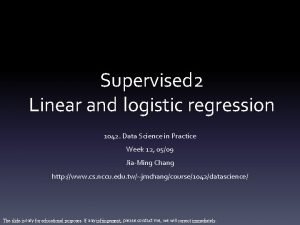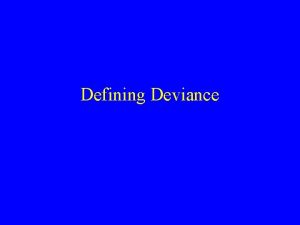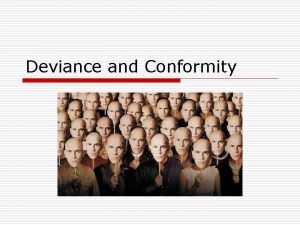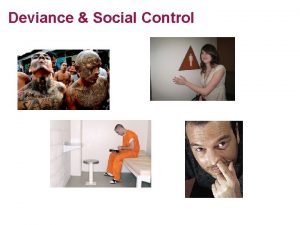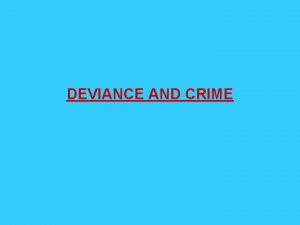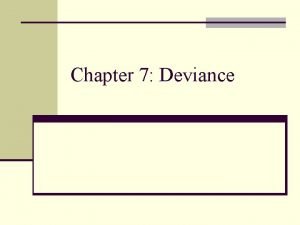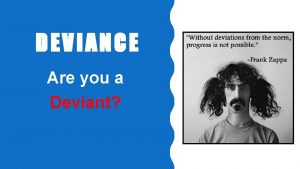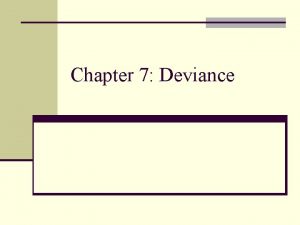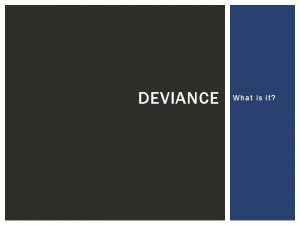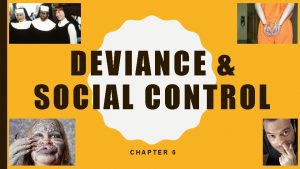What is Deviance Defining Deviance Not perversion or










- Slides: 10

What is Deviance?

Defining Deviance �Not perversion or depravity �Deviance = behaviour that violates the standards of conduct or expectations of a group or society �Based on this sociological definition, deviance is universal. �We are all deviant from time to time. �Each of us violates common social norms in certain situations.

Examples of Deviance �Alcoholics, compulsive gamblers, and people with mental illnesses would be classified as deviants. �Deviant acts = being late for class, dressing too casually for a formal wedding

Is Being Overweight an Example of Deviance? �Beauty myth (exagerrated ideal of beauty, beyond the reach of all but a few females – Naomi Wolf) �In order to shed their “deviant” image and conform to (unrealistic) societal norms, many women and girls become consumed with adjusting their appearances.

Deviance �Involves the violation of group norms, which may or may not be formalized into law. �Comprehensive concept that includes not only criminal behaviour but also many actions not subject to prosecution. �Deviation from norms is not always negative or criminal

Normative Standards �Deviance is viewed according to normative standards. �It is subject to social definitions within a particular society. �In most instances, those individuals and groups with the greatest status and power define what is acceptable and what is deviant

Deviance and Social Stigma �Some people are unwillingly cast in negative social roles. �Stigma (Goffman 1963) = sociological theory to describe the labels society uses to devalue members of certain social groups �Prevailing expectations about beauty and body shape may prevent people who are regarded as ugly or obese from advancing as rapidly as their abilities permit.

Social Stigma Continued… �Obese or anorexic = assumption of weak character, viewed as “disfigured” or “strange” �Goffman called it “spoiled identity” �What constitutes disfigurement is up for interpretation �Many women who are considered “normal” looking still have plastic surgery �Not just women who feel uncomfortable with their appearance �Men accounted for 9% of plastic surgery in 2006

Stigma for past behaviour �People are often stigmatized for deviant behaviour they may no longer engage in. �Labels like “compulsive gambler”, “exconvict”, “recovering alcoholic”, “exmental patient” can stick with a person for life. �Stigma symbol (Goffman) = symbol that discredits or debases a person’s identity (ex. child molester) �Often times these stigma symbols may not be obvious but are a matter of public record.

The Stigma of Homelessness �Have trouble getting job �Employers are wary of applicants who cannot give a home address �Difficult to hide homelessness �Regardless of a person’s positive attributes, employers can regard the spoiled identity of homelessness as sufficient reason to dismiss an employee
 Sexual perversion
Sexual perversion Defining and non defining relative clauses in telugu
Defining and non defining relative clauses in telugu Defining non defining relative clauses
Defining non defining relative clauses Adjectival clauses
Adjectival clauses Relative clauses defining and non defining
Relative clauses defining and non defining Prepositions in relative clauses
Prepositions in relative clauses Relative pronouns defining and non-defining
Relative pronouns defining and non-defining Logistic regression residual deviance
Logistic regression residual deviance Sadlier level d unit 1 synonyms
Sadlier level d unit 1 synonyms Lady montague defining quotes
Lady montague defining quotes Aplusphysics kinematics-free fall
Aplusphysics kinematics-free fall







